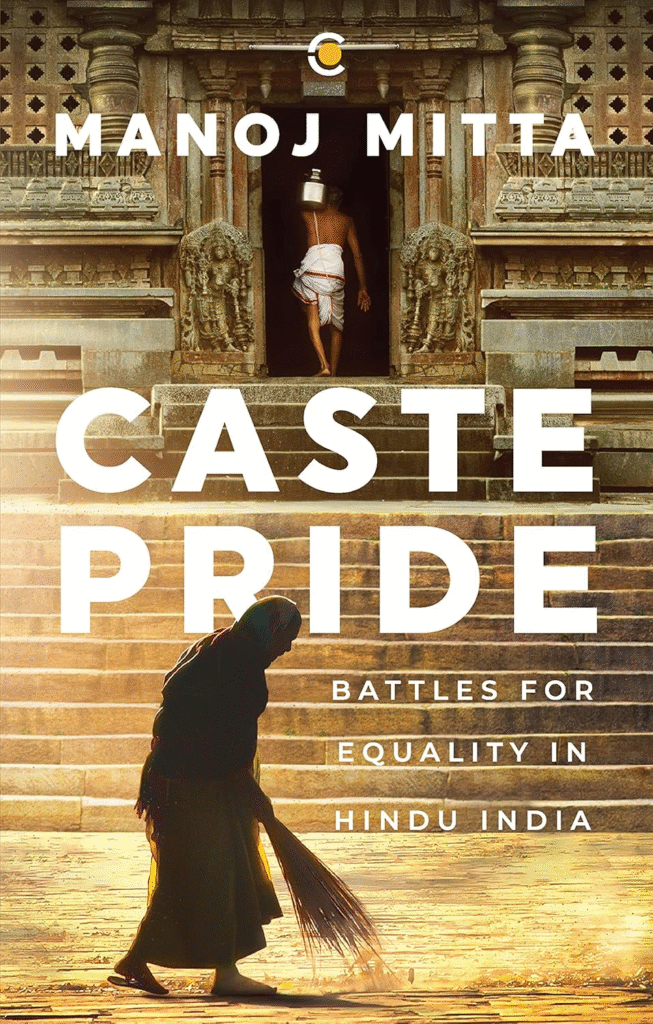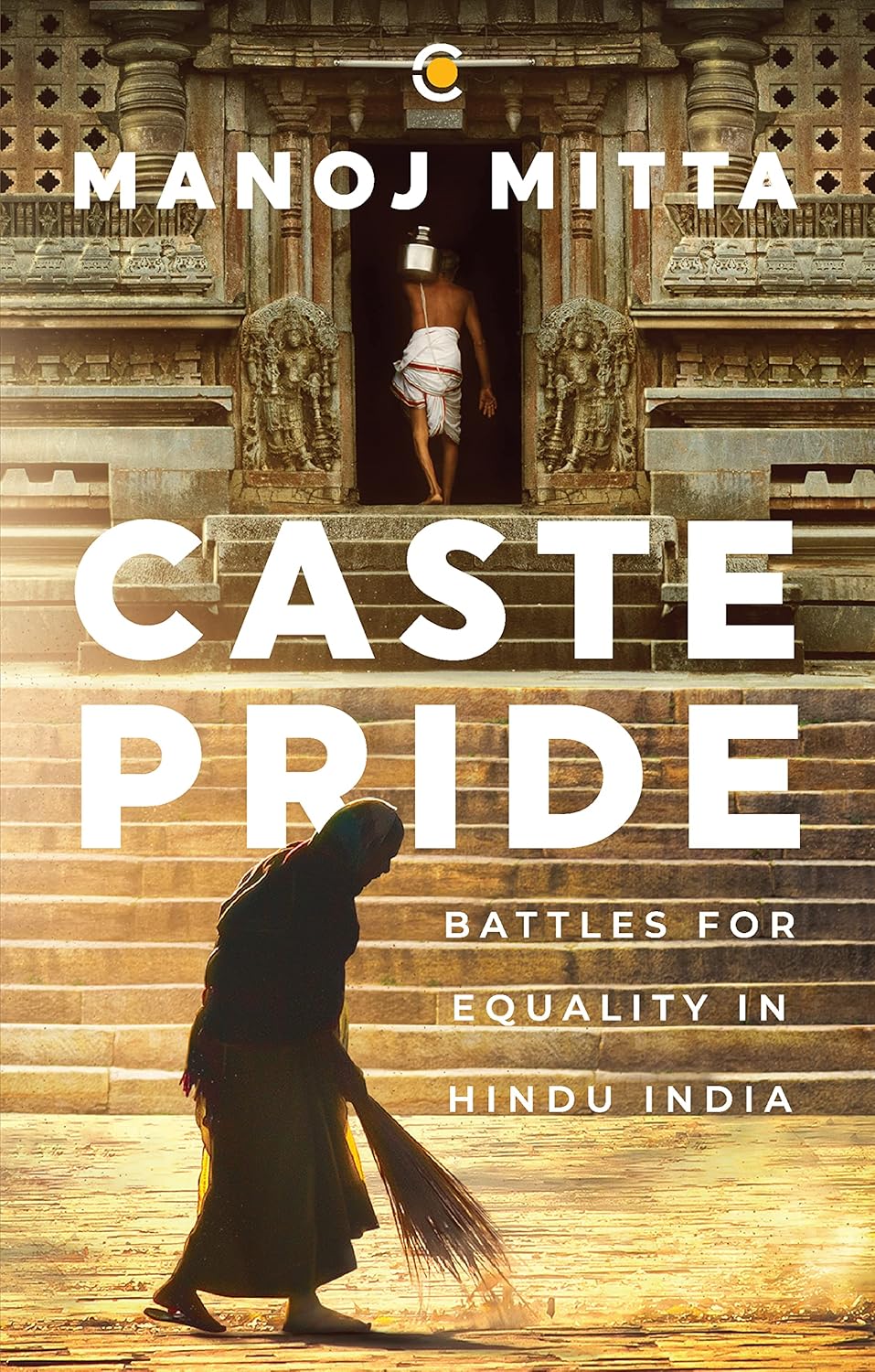Caste Pride: Battles for Equality in Hindu India by Manoj Mitta is not just another book on caste instead it is a groundbreaking, eye-opening deep dive into the centuries-old caste system of Hindu society, told through the powerful lens of law and justice. Written by the acclaimed journalist Manoj Mitta, this book has earned immense recognition, including winning the Atta Galatta Bangalore Literature Festival (BLF) Book Prize 2023 for Best Non-Fiction, the Kalinga Literary Festival (KLF) Non-Fiction Book Award (2023–2024), and the Valley of Words (VoW) English Non-Fiction Award (2024). It is a compelling, well-researched work that uncovers India’s long, painful history of caste discrimination and the legal battles fought to challenge it.

In Caste Pride, Manoj Mitta uses judicial records, legislative debates, and social reform movements to chart a radically new history of caste in India. What sets this book apart is its methodical arrangement of landmark legal cases both pre- and post-Independence and making it an essential reference for anyone wanting to understand how caste shaped, and continues to shape, Indian law and society. Each chapter digs deep into issues such as untouchability, inter-caste marriages, temple entry, property rights, and access to education. This makes Caste Pride a unique and valuable addition to the growing literature on caste-based inequality.
What makes Caste Pride truly powerful is its commitment to showcasing the real stories behind the laws. From historical figures like Savitribai Phule and B.R. Ambedkar to lesser-known reformers and even colonial administrators who played crucial roles, the book humanizes the complex legal and social fight against caste injustice. With detailed references and real courtroom battles, this book also acts as a tribute to the countless changemakers who stood up to systemic discrimination, often at great personal cost. For readers who want to understand how caste continues to influence modern India, Caste Pride is an unmissable read.
This extraordinary book challenges the reader to think deeply about justice, equality, and the role of law in shaping social change. Whether you are a policymaker, a student of history, or simply a concerned citizen, Caste Pride will leave you more informed, more thoughtful, and perhaps even more determined to be a part of the ongoing battle against caste discrimination.
Read Also: Kargil War: The Turning Point by M B Ravindranath
Book Availability, Formats, and Pricing

Caste Pride: Battles for Equality in Hindu India by Manoj Mitta is a groundbreaking and award-winning non-fiction book that explores the complex history of the caste system in India through the lens of legal reform and social movements. Published on 24 April 2023 by Context, an imprint of Westland Books (a division of Nasadiya Technologies Pvt Ltd), this 624-page English hardcover edition has earned accolades such as the Atta Galatta Bangalore Literature Festival (BLF) Book Prize 2023 and the Kalinga Literary Festival (KLF) Non-Fiction Book Award (2023–2024). The book is available in both digital and print formats, with the Kindle edition priced at ₹550 and the hardcover typically available for ₹578 on Amazon India. Flipkart, BidCurios, and other online retailers also list it, with prices ranging from ₹689 to ₹799 based on discounts. International readers can purchase it via Amazon.com or eBay.
Read Also: The Mewar Conspiracy – Historical Novel by Rrashima Verma
About the Author of Caste Pride
Manoj Mitta is a senior journalist, legal expert, and author known for his fearless reporting and in-depth analysis of India’s most pressing human rights and constitutional issues. With decades of experience in investigative journalism, he has worked with some of India’s leading newspapers, including The Times of India and The Indian Express. His reporting often focuses on legal affairs, civil rights, caste discrimination, and mass violence, and he is widely respected for his ability to unearth uncomfortable truths hidden in official records and legal archives.
Mitta’s writing is defined by clarity, meticulous research, and a deep commitment to justice. Before Caste Pride: Battles for Equality in Hindu India, he co-authored When a Tree Shook Delhi: The 1984 Carnage and Its Aftermath with H.S. Phoolka, a powerful account of the anti-Sikh riots. He also authored The Fiction of Fact-Finding: Modi and Godhra, a critical examination of the 2002 Gujarat riots and the legal process surrounding them. Both books reflect his enduring commitment to documenting state-sponsored violence and legal failures.
With Caste Pride, Manoj Mitta has turned his investigative lens toward caste injustice, drawing from two centuries of judicial and legislative records to build one of the most comprehensive accounts of caste and law in India. His work not only brings forgotten voices and buried cases into public view but also challenges national narratives that ignore or sidestep caste realities.
Mitta’s contributions go beyond journalism and he is a public intellectual who uses his platform to provoke thought, inspire debate, and push for institutional accountability. His writings are widely read by scholars, legal professionals, policymakers, and activists alike, making him one of the most influential voices in contemporary India on issues of justice, equality, and constitutional morality.
Read Also: What Does Israel Fear from Palestine? by Raja Shehadeh
Thematic Analysis of Caste Pride
- Legal Struggles that Shaped India’s Caste History: One of the most powerful themes of this book is the deep dive into legal struggles that shaped caste dynamics in India. The author traces how various laws either supported caste discrimination or were used as tools to resist it. These laws and court cases reflect the complex relationship between state authority and social justice. From colonial-era legislation to modern judicial verdicts, the book presents a legal timeline of caste issues that still resonate today. Caste Pride shows that the courtrooms were not just places of law, but also battlegrounds for dignity and equality.
- Resistance and Rebellion by Marginalized Communities: The book highlights how oppressed communities, particularly Dalits, actively resisted caste oppression through organized protests and community action. From water rights to temple entry, these movements were about reclaiming human rights. Public demonstrations like Ambedkar’s Mahad Satyagraha were turning points that shook the foundations of caste-based power. These stories show us that the fight was never passive and it was filled with fierce determination and collective strength. Caste Pride captures the spirit of resistance that pulses through every page of the book.
- Contributions of Social Reformers and Thinkers: The efforts of reformers like Savitribai Phule, Periyar, M.C. Rajah, and Dr. B.R. Ambedkar take centre stage in this book. Their vision, courage, and activism played crucial roles in breaking down social hierarchies. The book also explores the influence of lesser-known leaders who challenged Brahmanical dominance through education, political representation, and spiritual reform. These pioneers laid the foundation for modern India’s ongoing fight against social inequality. Caste Pride pays tribute to these visionaries whose legacies continue to inspire.
- Colonial Rule and the Codification of Caste: During British rule, the caste system was not dismantled but further structured through bureaucratic classifications and legal codes. The colonial administration, hesitant at first, slowly began enacting policies that unintentionally strengthened caste divisions. These policies affected everything from education and employment to access to justice. By documenting these effects, Caste Pride uncovers how colonial interventions laid the groundwork for institutionalized inequality that still lingers today.
- Why Caste Has Been Neglected in Indian Historiography: The book provides a sobering reflection on why caste has remained at the margins of Indian historiography. Historians focused primarily on anti-colonial resistance, sidelining the struggle against internal social injustices. Since the enemy was a foreign ruler, caste oppression often practiced by the elite within Hindu society so it remained a taboo topic. Caste Pride corrects this narrative, pushing caste back into the spotlight where it belongs.
- Gendered Dimensions of Caste Discrimination: The book takes a sharp look at how caste-based violence intersects with gender. Dalit women have historically borne the brunt of both caste and patriarchal oppression. Stories of women punished for dressing “above their caste” or denied basic rights underscore the cruel reality of layered discrimination. Caste Pride reveals how legal and social systems failed to protect women from this double burden, making their stories essential to understanding the full impact of caste.
- Social Elites and Their Opposition to Reform: Upper-caste elites, particularly Brahmins, often resisted reforms that aimed to uplift marginalized groups. The book shows how they challenged policies, blocked legislation, and used religion as a shield against equality. This resistance was not limited to the pre-Independence era but continues to echo in contemporary politics. By examining these power structures, Caste Pride explains why caste remains deeply embedded in Indian society, even in modern times.
- The Hidden Role of Non-Hindu and Marginalized Voices: Another unique contribution of Caste Pride is its recognition of individuals outside the traditional Hindu and Congress narrative. The book highlights overlooked reformers like Maneckji Dadabhoy, a Parsi legislator who was among the first to raise untouchability issues in colonial legislatures. It celebrates non-dominant voices that were pivotal in pushing social reforms when mainstream Hindu leaders stayed silent. By including these perspectives, Caste Pride broadens the lens through which we view India’s legal and social evolution.
- Structural Bias in the Indian State Apparatus: Rather than portraying caste injustice as accidental, Caste Pride reveals how caste oppression has been structurally embedded in the Indian state from colonial administrators to modern courts. The book shows how the judiciary, legislature, and law enforcement have often upheld caste hierarchies rather than dismantling them. This systemic bias was not just a matter of bad implementation and it was woven into the framework of governance. Caste Pride makes it clear that caste inequality cannot be resolved without addressing institutional complicity.
- Inter-Caste Marriage as a Site of Resistance and Violence: A particularly important focus of the book is the legal and social backlash against inter-caste marriages. The long battle to legalize such unions, and the violence they continue to attract even in progressive states, forms a key theme. The story of Vithalbhai Patel’s 1918 bill is emblematic of how even simple reforms met intense opposition. Caste Pride powerfully illustrates how marriage continues to be a battleground for caste purity and social control, with honour killings still haunting modern India.
- Regional Movements that Defied Caste Authority: Movements like the Satyashodhak Samaj in Maharashtra, the Dravidian uprising in Tamil Nadu, and the Lingayat reform in Karnataka are deeply explored. These regional revolts provided a collective voice to marginalized groups and challenged the authority of caste priests and traditions. Each movement contributed uniquely to the national anti-caste discourse. Caste Pride shows how local struggles fuelled a national transformation toward justice and equality.
- The Judiciary’s Role in Perpetuating Caste Injustice: One of the bold claims of the book is that India’s judiciary has not always been a friend of the oppressed. Many legal judgments failed to punish perpetrators of caste-based crimes or denied justice to victims. The book outlines numerous cases where courts showed bias or failed to interpret laws in favour of marginalized communities. This theme forces us to reflect on the impartiality of institutions we often trust. Caste Pride makes it clear that even the law is not immune to social bias.
- Religious Institutions and Their Complicity: Religion has long been used to justify caste hierarchies, and the book does not shy away from criticizing this. Hindu temples, religious texts, and rituals have all played roles in reinforcing inequality. At the same time, reformers within the religious fold tried to reinterpret these practices to support equality. This internal conflict within Hinduism is presented with great nuance. Caste Pride uses these examples to highlight the spiritual and social complexities in the fight for caste reform.
- Emotional and Psychological Toll of Caste Oppression: Beyond legal and political struggles, the book powerfully describes the emotional pain of those who suffered caste-based violence and humiliation. Personal stories reveal the deep scars left by systemic discrimination and stories of children shunned in schools, adults denied jobs, or entire families subjected to violence. Caste Pride gives voice to these untold stories, reminding readers that caste is not just a social category and it is a lived experience of suffering and survival.
- Archival Blind Spots and the Challenge of Research: A striking point in Manoj Mitta’s discussion is the inaccessibility of legal archives and the lack of public awareness about caste-related laws. Caste Pride emerged from the author’s seven-year journey into forgotten archives that even iconic thinkers like Dr. Ambedkar missed. This research gap, especially when compared with the rich archival material on race in the US, highlights the neglect of caste in India’s official record-keeping. Caste Pride addresses these blind spots by recovering critical documents and offering them to the public for the first time.
- A Call to Action for an Equal Future: The final theme is a clear call to action. The book ends by stressing that while progress has been made, the caste problem is far from solved. Discrimination continues in schools, workplaces, politics, and even in marriage. Readers are urged to recognize their role in dismantling caste, not just in law but in everyday life. Caste Pride is not just a history book but it is a mirror and a message that the fight for equality must go on.
- Caste and Modern Identity Politics: Manoj Mitta’s work resonates deeply in today’s India, where caste still determines access to resources, representation, and justice. From electoral politics to institutional appointments, caste continues to define opportunity and exclusion. Caste Pride links past legal battles with present-day caste identity politics, offering a framework to understand how legal victories have not always translated into social change. Caste Pride is especially relevant for readers who want to explore how caste shapes contemporary power dynamics.
Deeply researched and rich with archival materials, Caste Pride is not only a vital addition to India’s socio-legal literature but also a must-read for anyone seeking to understand the legal, historical, and human dimensions of caste inequality.
Read Also: Original Sin by Stanly Johny: Book Review
What Experts and Scholars Are Saying About Caste Pride
- Ajay Skaria, Professor of History, described the book as a powerful and honest account that uncovers not just familiar incidents but also lesser-known and rarely studied aspects of caste violence.
- Anand Teltumbde, civil rights activist and scholar, called it invaluable for debunking myths, reviving forgotten heroes, and correcting long-standing factual and judgmental errors in caste discourse.
- Anurag Bhaskar, constitutional expert, emphasized how the book reveals the deep links between caste and legal systems, showing how caste bias infiltrated even so-called neutral laws.
- Christophe Jaffrelot, political scientist and author, found the work to be truly remarkable—carefully researched, nuanced, and essential for anyone studying caste.
- Marc Galanter, legal scholar, highlighted it as a fresh and insightful addition to caste literature and India’s ongoing legal journey toward reform.
- Meena Kandasamy, poet and novelist, urged readers to use this book as a tool to challenge caste denial, calling it powerful enough to hurt and solid enough to heal.
- Satish Deshpande, professor of sociology, admired the book’s sweeping documentation of two centuries of caste-related legal developments, calling it stunning in its impact.
- Uma Chakravarti, feminist historian, praised its depth, passion, and scale, framing it as an archive that captures the emergence of a new social order rooted in equality and justice.
Why This Book Deserves Your Attention
Read Also: Wafadari Imaandari Zimmedari by Lt Gen Dhillon
Caste Pride fills a long-standing gap in how India’s caste system has been historically and legally documented. Unlike typical narratives that focus solely on the sociological or religious aspects of caste, this book boldly examines two centuries of caste-based injustices through legislative records, courtroom battles, and overlooked reform efforts. Manoj Mitta does not just retell known stories as he uncovers new archival evidence, brings unheard voices to the forefront, and challenges the blind spots of India’s nationalist icons, showing how deeply ingrained caste bias was and still is even in the nation’s most celebrated institutions.
This book deserves our attention because it brings clarity to the often-hidden intersections of law, caste, and power. It tells us why the Indian legal system has failed many of its most marginalized citizens, and how even the judiciary meant to uphold justice which has sometimes enabled caste oppression. It also reminds us that freedom from colonial rule did not mean freedom for everyone, especially for Dalits and lower castes, who continued to face discrimination and violence even in independent India.
Most importantly, Caste Pride is not just a book but it is a wake-up call. It urges us to confront uncomfortable truths, re-examine glorified histories, and question the role of law, leadership, and society in perpetuating inequality. For students, scholars, policymakers, and anyone who truly wants to understand the roots of social injustice in India, this book is not just recommended but it’s essential.
Final Thought
Caste Pride: Battles for Equality in Hindu India is a groundbreaking work that reshapes how we understand caste by uncovering its deep entanglement with law, politics, and power. Manoj Mitta brings to light rare archival records, forgotten legal battles, and the overlooked role of institutions like the judiciary in sustaining caste hierarchies, making it clear that caste is not just a relic of history but a living system of inequality in modern India. Through powerful storytelling and bold analysis, the book challenges glorified narratives of the freedom struggle, holds revered leaders accountable for their caste blind spots, and honors the courage of those who fought for justice. It bridges the gap between law and lived reality, offering fresh insight into how caste has been both resisted and reinforced over time. As both a historical record and a call to action, Caste Pride is essential reading for anyone seeking to understand and dismantle caste-based discrimination in India today.
Read Also: Gods Guns & Missionaries by Manu S Pillai




